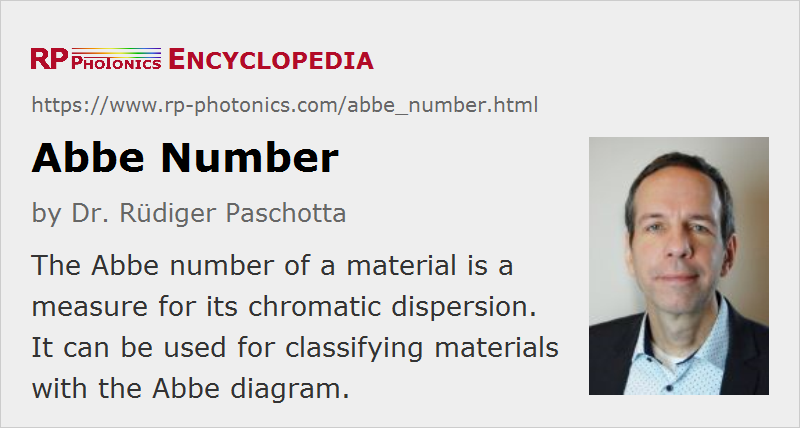Abbe Number
Definition: a measure for the chromatic dispersion of a transparent material
Alternative terms: V-number, constringence
German: Abbe-Zahl
Formula symbol: <$\nu_\textrm{D}$>
Author: Dr. Rüdiger Paschotta
Cite the article using its DOI: https://doi.org/10.61835/evu
Get citation code: Endnote (RIS) BibTex plain textHTML
The Abbe number of a transparent optical material, named after the German physicist Ernst Abbe, is defined as
$${\nu _{\rm{D}}} = \frac{{{n_{\rm{D}}} - 1}}{{{n_{\rm{F}}} - {n_{\rm{C}}}}}$$This the ratio of the refractivity and the principal dispersion. It is also sometimes called the V-number <$V_\textrm{D}$> or the constringence.
The definition refers to refractive indices at three different standard spectral lines in the visible region, which can easily be produced with spectral lamps:
- <$\lambda_\textrm{F}$> = 486.1 nm (blue Fraunhofer F line from hydrogen)
- <$\lambda_\textrm{D}$> = 589.2 nm (orange Fraunhofer D line from sodium)
- <$\lambda_\textrm{C}$> = 656.3 nm (red Fraunhofer C line from hydrogen)
The middle one (from the sodium D line) lies in the region of maximum sensitivity of the human eye.
In some cases, somewhat different wavelength values corresponding to other standard spectral lines are used, e.g., 480.0 nm (F' line), 587.6 nm (d line) and 643.9 nm (C' line); this leads to the modified Abbe number <$\nu_\textrm{d}$>. All those wavelengths can be obtained from common gas discharge lamps.
Relation to the Chromatic Dispersion of Lenses
With the Abbe number, one can easily estimate the change of focal length of a simple optical lens made from a material:
$${f_{\rm{F}}} - {f_{\rm{C}}} = - \frac{{{f_{\rm{D}}}}}{{{\nu _{\rm{D}}}}}$$The formula is not exact because it is based on a Taylor expansion, but it is normally good enough for practical purposes. It shows that the mismatch of focal length values between the blue and red spectral regions is inversely proportional to the Abbe number.
From that equation, it follows that an achromatic doublet lens needs to fulfill the condition
$${\nu _1}\;{f_1} + {\nu _2}\;{f_2} = 0$$containing the Abbe numbers and focal lengths of the two lens components.
Abbe Diagram
A good overview over different glass types can be obtained with an <$n-\nu$> diagram (Abbe diagram), where each glass is represented by a point, where the coordinates are the Abbe number and the refractive index <$n$>:

Glasses with a relatively low Abbe number of less than 50 (i.e., with relatively strong dispersion) are called flint glasses, whereas glasses with a higher Abbe number are crown glasses. Typically, flint glasses have relatively high refractive indices, whereas crown glasses exhibit lower values.
Secondary Spectrum
Obviously, the consideration of refractive indices at only three wavelengths leads to a rather crude measure of chromatic dispersion. Early attempts to achieve more comprehensive characterizations of optical materials involved the consideration of the so-called secondary spectrum via relative partial dispersions, which are ratios of refractive index differences for different sets of wavelengths:
$$\begin{array}{l} {P_\rm{C,t}} = ({n_{\rm{C}}} - {n_{\rm{t}}})/({n_{\rm{F}}} - {n_{\rm{C}}})\\ {P_\rm{C,s}} = ({n_{\rm{C}}} - {n_{\rm{s}}})/({n_{\rm{F}}} - {n_{\rm{C}}})\\ {P_\rm{F,e}} = ({n_{\rm{F}}} - {n_{\rm{e}}})/({n_{\rm{F}}} - {n_{\rm{C}}})\\ {P_\rm{g,F}} = ({n_{\rm{g}}} - {n_{\rm{F}}})/({n_{\rm{F}}} - {n_{\rm{C}}})\\ {P_\rm{i,g}} = ({n_{\rm{i}}} - {n_{\rm{g}}})/({n_{\rm{F}}} - {n_{\rm{C}}}) \end{array}$$Such values are listed in catalogues for many optical glasses, and they can be used for calculating or estimating refractive index differences for various additional wavelengths.
Modern Quantification of Chromatic Dispersion
The modern way of quantifying chromatic dispersion is no longer relying on refractive indices for specific spectral lines. Instead, it is based on derivatives of wavenumbers – either a range of dispersion orders for a certain central wavelength or the wavelength-dependent group delay dispersion. Such quantities can be numerically calculated from Sellmeier equations, for example; Sellmeier data can also be found in glass catalogues.
More to Learn
Encyclopedia articles:
Questions and Comments from Users
Here you can submit questions and comments. As far as they get accepted by the author, they will appear above this paragraph together with the author’s answer. The author will decide on acceptance based on certain criteria. Essentially, the issue must be of sufficiently broad interest.
Please do not enter personal data here; we would otherwise delete it soon. (See also our privacy declaration.) If you wish to receive personal feedback or consultancy from the author, please contact him, e.g. via e-mail.
By submitting the information, you give your consent to the potential publication of your inputs on our website according to our rules. (If you later retract your consent, we will delete those inputs.) As your inputs are first reviewed by the author, they may be published with some delay.

 general optics
general optics
Connect and share this with your network:
Follow our specific LinkedIn pages for more insights and updates: